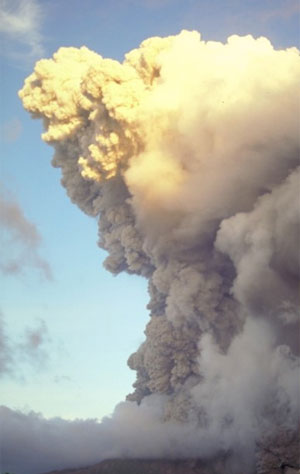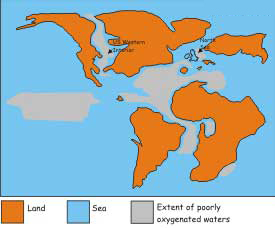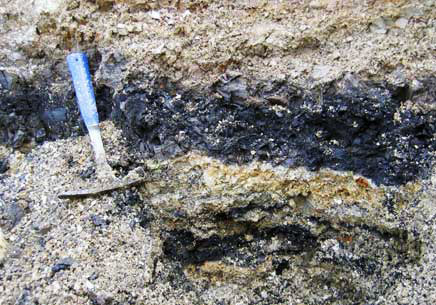Greenhouse Earth — the story of ancient climate change
The carbon dioxide released from the burning of fossil fuels is accumulating as an insulating blanket around our planet, trapping more of the Sun's heat energy in our atmosphere.
To combat this, the Earth Challenge Prize was launched in February 2007 by American politician Al Gore and the entrepreneur Sir Richard Branson.
The prize of $25 million will be given to whoever can devise a method for removing a billion tonnes of carbon dioxide from our atmosphere each year.
Earth's natural mechanisms
However, scientists are now beginning to discover that when naturally-induced global warming has occurred in the past, the Earth has a natural mechanism for dealing with this problem, but one that mankind cannot rely on to solve the current crisis.
This is the story one of the largest of these natural events that occurred more than 90 million years ago.
Our story begins in the Late Cretaceous (99 to 65 million years ago) when dinosaurs were still the dominant land vertebrates.
The previous 20 million years witnessed extreme levels of marine volcanic activity; huge amounts of basaltic lava were erupted at the fractured boundaries of the tectonic plates running beneath the Pacific and Atlantic oceans.
Elsewhere, unusually large accumulations of molten basalt had erupted through these plates, forming large areas of greatly thickened oceanic crust known as ocean plateaus.
Volcanic gases released by these eruptions were rich in carbon dioxide and sulphur dioxide, and although some carbon dioxide was absorbed by the oceans, much found its way into the atmosphere.
Analysis of fossil soil horizons and fossil plant remains suggests that Late Cretaceous atmospheric carbon dioxide levels peaked at between four and 18 times current levels.
Sulphur dioxide dissolves in water forming a strong acid, and this may have corroded oceanic deposits of limestone, releasing more carbon dioxide.
Late Cretaceous greenhouse gases

During the Late Cretaceous, the high levels of atmospheric carbon dioxide heated up the Earth in the same way as they do today.
Even high latitudes were affected, with land areas becoming colonised by lush sub-polar forests, and ice largely absent from our planet.
At this time, thick deposits of chalk were accumulating in warm seas across southern England. This rock, which now forms the famous white cliffs of the Sussex and Kent coast, contains microscopic fossils that preserve a chemical signal of the sea temperature in the Late Cretaceous.
This evidence shows that the seas and oceans were becoming progressively warmer, with sea surface temperatures around Britain probably reaching 28°C. Even deep ocean water seems to have been warm, perhaps as high as 15°C, compared with the near-freezing deep ocean water of today.
Oxygen-starved seas
A critical point was reached about 93 million years ago, at a time designated by geologists as the Cenomanian/Turonian boundary.
The exact sequence of events is still not clear, but the end result is almost beyond question.
In all the deep oceans of the world, and some of the shallow seas, there was a sudden appearance of dark mudstones, containing high levels of organic carbon.
Normally organic matter decays upon the death of the organism that produced it, and the nutrients and carbon are consumed by other life forms.
Only where oxygen is largely absent can substantial amounts of organic matter become preserved, and the organic carbon concentrated.
This may occur in isolated lakes and seas that are largely cut off from fresh supplies of oxygenated water.
However, at the Cenomanian/Turonian boundary, all the deep oceans and some shallow seas appear to have become temporarily oxygen-starved.
This event is known as an oceanic anoxic event, and the organic-rich muds that are formed are called 'black shales'.
The seas covering southern England were too shallow and aerated to form black shales at this time, but they did form in the deeper water covering Lincolnshire and Yorkshire, where a dark mudstone known as the 'Black Band' represents this event.
Ocean 'dead zones'
Oxygen-starvation of the oceans on a global scale seems an improbable event, but recently an area of the Pacific Ocean off the north-west coast of the United States experienced just such a fate: Ocean 'dead zones' spell disaster as wind patterns change | Guardian 2007.
In this case the decomposing remains of an unusually rich bloom of plankton consumed the oxygen in the water.
Fish, crabs and marine worms all perished in a brief period of anoxia.
In the Late Cretaceous the oxygen-starvation lasted much longer, perhaps between 400 000 and 800 000 years, although occasional pale-coloured beds in black shale horizons suggest brief periods of better oxygenation.
The cause of the Late Cretaceous oceanic anoxic event is still uncertain, but it seems to be related to a rise in global sea levels.
This may have triggered an explosion of life in near-surface waters and/or funnelled poorly oxygenated, dense, saline currents from newly created shallow seas into deep ocean basins.
Certainly the high temperatures of both surface and deep ocean waters suggest a limited holding capacity for dissolved oxygen compared to modern oceans.
How the oceans might regulate our atmosphere and climate

There is a balance between the gases in the atmosphere and the gas dissolved in the oceans.
Carbon dioxide consumed by photosynthesising plankton (phytoplankton) in the ocean is usually quickly returned to the ocean by decay of the phytoplankton or of the animals in the food chain above.
n this way the ocean-atmosphere balance is maintained. However, in an oxygen-starved ocean, organic matter is not recycled and instead accumulates to form black shales.
The ocean becomes depleted in carbon dioxide and is no longer in balance with the atmosphere. Theoretically, this balance could be restored by more atmospheric carbon dioxide being drawn down into the oceans.
In this way it is thought that oxygen starvation of the oceans in the Late Cretaceous allowed the oceans to lower carbon dioxide in the atmosphere and initiate global climatic cooling.
Unresolved mystery?
Whilst the cause of oceanic anoxic events might still be unresolved, there is growing evidence that they represent Earth's natural response to ending extreme greenhouse climates.
If we return to the chalk cliffs of southern England, the microscopic fossils that showed a progressive warming trend before the deposition of black shales in the deep oceans also show a long-term cooling trend afterwards.
This suggests falling atmospheric carbon dioxide levels.
The locking away of organic matter in black shales prevented it from being recycled to the oceans to sustain new life.
As the dissolved carbon dioxide in the oceans became used up, more was absorbed from the atmosphere.
Since fresh volcanic supplies of carbon dioxide had now dwindled, the effect was long-term cooling down of our planet for the remainder of the Cretaceous.
What next?
The continued study of ancient greenhouse climates offers us one of the best means of predicting what the future effects of modern global warming might be.
References
Wignall, P B. 1994. Black Shales. (Clarendon Press: Oxford.)
Further reading
Jenkyns, H C. 2003.
Evidence for rapid climate change in the Mesozoic – Palaeogene
greenhouse world.
Philosophical Transactions of the Royal Society, Vol.
361, 1885 – 1916.
Jones, C E, and Jenkyns,
H C. 2001.
Seawater strontium isotopes, oceanic anoxic events, and seafloor
hydrothermal activity in the Jurassic and Cretaceous.
American Journal of Science, Vol. 301, 112 – 149.
Kerr, A C. 2005.
Oceanic LIPs: The kiss of death.
Elements, Vol. 1, 289 – 292.
Kerr, A C. 1998.
Oceanic plateau formation: a cause of mass extinction and black
shale deposition around the Cenomanian – Turonian boundary.
Journal of the Geological Society of London, Vol. 155,
619 – 626.
Contact
For more information contact:
Mark Woods
- Images courtesy of the International Ocean Drilling Program










